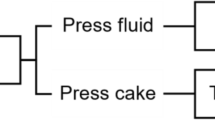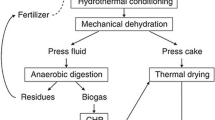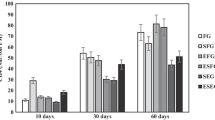Abstract
Urban biomass from green areas is a potential resource for bioenergy recovery, which is widely unused. Different types of organic material (e.g., grass, leaf litter) usually occur in mixtures due to common collecting practice. Forty samples of grass, leaf litter (genera: Acer, Quercus, Tilia), and mixtures of both, containing one third grass or leaf litter, were investigated to evaluate the effect of the “Integrated Generation of Solid Fuel and Biogas from Biomass” (IFBB) on material and energy fluxes as well as relevant characteristics of resulting energy carriers. IFBB divides biomass into a fiber-rich press cake and a highly digestible press fluid by mashing with subsequent pressing. Ensiling of samples was successful with pH values ranging from 4.2 in grass to 4.8 in pure Tilia samples. Concentration of most minerals with exception of Ca and Mg were higher in grass than in leaf litter silage. The IFBB treatment reduced the element concentration in the press cake independently from the substrate. Linear regression models revealed high influence of the initial concentration in silage on the concentration in the press cake. The lower heating value of the press cake was nearly constant (19 MJ kg−1 DMash free) independent from mixture. Methane yields from press fluid digestion ranged from 172 (mean of leaf litter samples) to 325 lN kg−1 VS (mixture of 33 % leaf litter—66 % grass). For an evaluation of the economic and ecological potential, models of the spatial and temporal occurrence of these biomasses need to be established.



Similar content being viewed by others
Abbreviations
- DM:
-
Dry matter
- FM:
-
Fresh matter
- GC-FID:
-
Gas chromatography with flame ionization detector
- ICP-OES:
-
Inductively coupled plasma optical emission spectrometry
- ICP-MS:
-
Inductively coupled plasma mass spectrometry
- IFBB:
-
Integrated generation of solid fuel and biogas from biomass
- LHV:
-
Lower heating value
- MF:
-
Mass flow
- NDF:
-
Neutral detergent fiber
- oDM:
-
Organic dry matter
- PF:
-
Press fluid
- PC:
-
Press cake
- RSC:
-
Ratio of standard deviation and standard error of cross-validation
- sd:
-
Standard deviation
References
Chiesura A (2004) The role of urban parks for the sustainable city. Landsc and Urban Plan 68(1):129–138. doi:10.1016/j.landurbplan.2003.08.003
Bolund P, Hunhammar S (1999) Ecosystem services in urban areas. Ecol Econ 29(2):293–301. doi:10.1016/S0921-8009(99)00013-0
Larondelle N, Haase D (2013) Urban ecosystem services assessment along a rural–urban gradient: a cross-analysis of European cities. Ecol Indic 29:179–190. doi:10.1016/j.ecolind.2012.12.022
Springer TL (2012) Biomass yield from an urban landscape. Biomass and Bioenergy 37:82–87. doi:10.1016/j.biombioe.2011.12.029
Kern M, Raussen T, Graven T et al (2012) Ökologisch sinnvolle Verwertung von Bioabfällen: Anregungen für kommunale Entscheidungsträger. BMU, Referat Öffentlichkeitsarbeit, Berlin
Prochnow A, Heiermann M, Plöchl M et al (2009) Bioenergy from permanent grassland – a review: 1. Biogas Bioresource Technol 100(21):4931–4944. doi:10.1016/j.biortech.2009.05.070
Jenkins BM, Baxter LL, Miles TR et al (1998) Combustion properties of biomass. Fuel Processing Technol 54(1–3):17–46. doi:10.1016/S0378-3820(97)00059-3
Liew LN, Shi J, Li Y (2012) Methane production from solid-state anaerobic digestion of lignocellulosic biomass. Biomass and Bioenergy 46:125–132. doi:10.1016/j.biombioe.2012.09.014
Wachendorf M, Richter F, Fricke T et al (2009) Utilization of semi-natural grassland through integrated generation of solid fuel and biogas from biomass. I. Effects of hydrothermal conditioning and mechanical dehydration on mass flows of organic and mineral plant compounds, and nutrient balances. Grass Forage Sci 64(2):132–143
Gamble JD, Jungers JM, Wyse DL et al. (2014) Harvest Date Effects on Biomass Yield, Moisture Content, Mineral Concentration, and Mineral Export in Switchgrass and Native Polycultures Managed for Bioenergy. Bioenerg. Res. doi:10.1007/s12155-014-9555-0
Tonn B, Dengler V, Thumm U et al (2011) Influence of leaching on the chemical composition of grassland biomass for combustion. Grass Forage Sci 66(4):464–473. doi:10.1111/j.1365-2494.2011.00804.x
Buxton DR, Muck RE, Harrison JH (eds) (2003) Silage Science and Technology, vol 42. American Society of Agronomy; Crop Science Society of America; Soil Science Society of America, Madison, Wis
McDonald P, Henderson N, Heron S (1991) The Biochemistry of Silage, 2nd edn. Chalcombe, Marlow, England
McEniry J, King C, O’Kiely P (2014) Silage fermentation characteristics of three common grassland species in response to advancing stage of maturity and additive application. Grass Forage Sci 69(3):393–404. doi:10.1111/gfs.12038
Khan N, Barman K, Rastogi A et al (2012) Chemical composition and digestion kinetics of mixed silages of maize fodder-tree leaves. Anim Nutr Feed Technol 12(2):271–278
Tjandraatmadja M, MacRae IC, Norton BW (1993) Effect of the inclusion of tropical tree legumes, Gliricidia sepium and Leucaena leucocephala, on the nutritive value of silages prepared from tropical grasses. J Agricultural Sci 120:397–406
Bazot S, Barthes L, Blanot D et al (2013) Distribution of non-structural nitrogen and carbohydrate compounds in mature oak trees in a temperate forest at four key phenological stages. Trees 27(4):1023–1034. doi:10.1007/s00468-013-0853-5
Tyler G (2005) Changes in the concentrations of major, minor and rare-earth elements during leaf senescence and decomposition in a Fagus sylvatica forest. For Ecology and Manag 206(1–3):167–177. doi:10.1016/j.foreco.2004.10.065
Piepenschneider M, de Moor S, Hensgen F et al (2015) Element concentrations in urban grass cuttings from roadside verges in the face of energy recovery. Environmental Sci Pollut Res 22(10):7808–7820. doi:10.1007/s11356-014-3881-9
Hensgen F, Richter F, Wachendorf M (2011) Integrated generation of solid fuel and biogas from green cut material from landscape conservation and private households. Bioresource Technol 102(22):10441–10450. doi:10.1016/j.biortech.2011.08.119
Jolliffe PA (2000) The replacement series. J Ecology 88(3):371–385. doi:10.1046/j.1365-2745.2000.00470.x
Hensgen F, Bühle L, Donnison I et al (2012) Mineral concentrations in solid fuels from European semi-natural grasslands after hydrothermal conditioning and subsequent mechanical dehydration. Bioresource Technol 118:332–342
Van Soest P, Robertson J, Lewis B (1991) Methods for dietary fiber, neutral detergent fiber, and nonstarch polysaccharides in relation to animal nutrition. J Dairy Sci 74(10):3583–3597. doi:10.3168/jds.S0022-0302(91)78551-2
Friedl A, Padouvas E, Rotter H et al (2005) Prediction of heating values of biomass fuel from elemental composition. Analytica Chimica Acta 544(1–2):191–198. doi:10.1016/j.aca.2005.01.041
Bühle L, Reulein J, Stülpnagel R et al (2012) Methane yields and digestion dynamics of press fluids from mechanically dehydrated maize silages using different types of digesters. Bioenergy Res 5(2):294–305. doi:10.1007/s12155-011-9127-5
Zerr W (2006) Versuchsanlage zur energetischen Beurteilung von Substraten und Kofermentaten für Biogasanlagen. Umweltwissenschaften und Schadstoff-Forschung 18(4):219–227
Verein Deutscher Ingenieure (2006) Guideline VDI 4630 Fermentation of organic materials; Characterisation of the substrate, sampling, collection of material data, fermentation tests. Beuth, Berlin
R Core Team (2013) R: A Language and Environment. R Foundation for Statistical Computing, Vienna, Austria
Casler MD, Vermerris W, Dixon RA (2015) Replication Concepts for Bioenergy Research Experiments. Bioenergy Res 8(1):1–16. doi:10.1007/s12155-015-9580-7
Fox J, Weisberg S (2011) An {R} Companion to Applied Regression, 2nd edn. Sage, Thousand Oaks CA
Cherney J, Cherney DJR (2003) Assessing Silage Quality. In: Buxton DR, Muck RE, Harrison JH (eds) Silage Science and Technology. American Society of Agronomy; Crop Science Society of America; Soil Science Society of America, Madison, Wis
Pahlow G, Muck RE, Driehuis F et al (2003) Microbiology of Ensiling. In: Buxton DR, Muck RE, Harrison JH (eds) Silage Science and Technology. American Society of Agronomy; Crop Science Society of America; Soil Science Society of America, Madison, Wis
Hopkins A, Adamson AH, Bowling PJ (1994) Response of permanent and reseeded grassland to fertilizer nitrogen. 2. Effects on concentrations of Ca, Mg, K, Na, S, P, Mn, Zn, Cu, Co and Mo in herbage at a range of sites. Grass Forage Sci 49(1):9–20. doi:10.1111/j.1365-2494.1994.tb01971.x
McGechan MB (1990) A review of losses arising during conservation of grass forage: Part 2, storage losses. J Agricultural Eng Res 45(0):1–30. doi:10.1016/S0021-8634(05)80135-0
McEniry J, Finnan J, King C et al (2012) The effect of ensiling and fractionation on the suitability for combustion of three common grassland species at sequential harvest dates. Grass Forage Sci 67(4):559–568. doi:10.1111/j.1365-2494.2012.00902.x
Scheffer F, Schachtschabel P, Blume H (2010) Lehrbuch der Bodenkunde, 16th edn. Spektrum Lehrbuch. Spektrum, Akad. Verl, Heidelberg, Berlin
Bühle L, Dürl G, Hensgen F et al (2014) Effects of hydrothermal conditioning and mechanical dewatering on ash melting behaviour of solid fuel produced from European semi-natural grasslands. Fuel 118:123–129. doi:10.1016/j.fuel.2013.10.063
Lin P, Wang W (2001) Changes in the leaf composition, leaf mass and leaf area during leaf senescence in three species of mangroves. Ecological Eng 16(3):415–424. doi:10.1016/S0925-8574(00)00126-9
Hagen-Thorn A, Varnagiryte I, Nihlgård B et al (2006) Autumn nutrient resorption and losses in four deciduous forest tree species. For Ecology Manag 228(1–3):33–39. doi:10.1016/j.foreco.2006.02.021
Bonsi M, Osuji P, Tuah A (1995) Effect of supplementing teff straw with different levels of leucaena or sesbania leaves on the degradabilities of teff straw, sesbania, leucaena, tagasaste and vernonia and on certain rumen and blood metabolites in Ethiopian Menz sheep. Anim Feed Sci Technol 52(1–2):101–129. doi:10.1016/0377-8401(94)00702-B
Salem AZM, Zhou C, Tan Z et al (2013) In vitro Ruminal Gas Production Kinetics of Four Fodder Trees Ensiled With or Without Molasses and Urea. J Integr Agriculture 12(7):1234–1242. doi:10.1016/S2095-3119(13)60438-4
Molina-Alcaide E, Yáñez-Ruiz D (2008) Potential use of olive by-products in ruminant feeding: a review. Anim Feed Sci Technol 147(1–3):247–264. doi:10.1016/j.anifeedsci.2007.09.021
Sharma R, Singh B, Sahoo A (2008) Exploring feeding value of oak (Quercus incana) leaves: Nutrient intake and utilization in calves. Livest Sci 118(1–2):157–165. doi:10.1016/j.livsci.2008.01.022
Lewandowski I, Kicherer A (1997) Combustion quality of biomass: practical relevance and experiments to modify the biomass quality of Miscanthus x giganteus. Eur J Agronomy 6(3–4):163–177. doi:10.1016/S1161-0301(96)02044-8
Heckman J, Kluchinski D (1996) Chemical composition of municipal leaf waste and hand-collected urban leaf litter. J Environ Qual 25(4):930. doi:10.2134/jeq1996.00472425002500040048x
Joergensen RG, Scholle GA, Wolters V (2009) Dynamics of mineral components in the forest floor of an acidic beech (Fagus sylvatica L.) forest. Eur J Soil Biol 45(4):285–289. doi:10.1016/j.ejsobi.2009.04.006
Steenari B, Lundberg A, Pettersson H et al (2009) Investigation of ash sintering during combustion of agricultural residues and the effect of additives. Energy Fuels 23(11):5655–5662
Maathuis FJM (2009) Physiological functions of mineral macronutrients. Curr Opin in Plant Biol 12(3):250–258. doi:10.1016/j.pbi.2009.04.003
Mattson W (1980) Herbivory in relation to plant nitrogen content. Annu Reviews Ecology Systematics 11:119–161
Bühle L, Hensgen F, Donnison I et al (2012) Life cycle assessment of the integrated generation of solid fuel and biogas from biomass (IFBB) in comparison to different energy recovery, animal-based and non-refining management systems. Bioresource Technol 111:230–239
Acknowledgments
The authors are grateful for receiving funding from the European Union through the Interreg IV B regional development fund for the COMBINE Project (Nr. 299J)
Author information
Authors and Affiliations
Corresponding author
Rights and permissions
About this article
Cite this article
Piepenschneider, M., Bühle, L. & Wachendorf, M. Solid Fuel Generation from Urban Leaf Litter in Mixture with Grass Cuttings: Chemical Composition, Energetic Characteristics, and Impact of Preprocessing. Bioenerg. Res. 9, 57–66 (2016). https://doi.org/10.1007/s12155-015-9661-7
Published:
Issue Date:
DOI: https://doi.org/10.1007/s12155-015-9661-7




